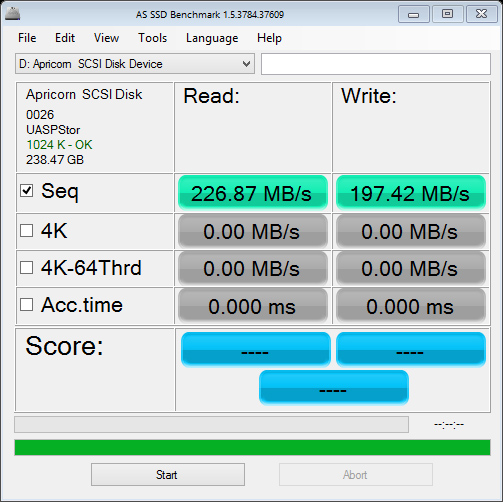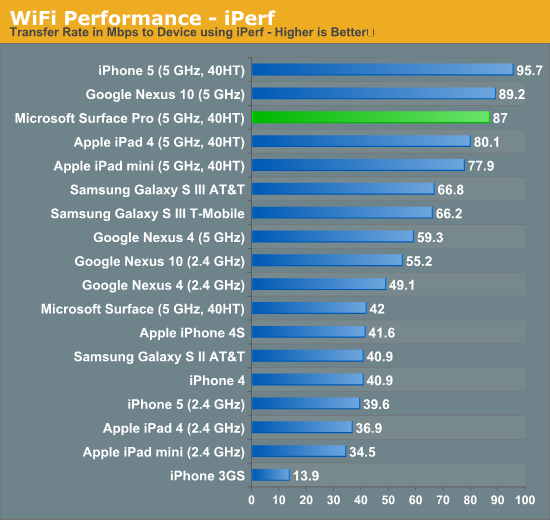Microsoft Surface Pro Review
by Anand Lal Shimpi on February 5, 2013 9:00 PM ESTFans and Thermals
While Surface RT was passively cooled, Surface Pro features two integrated fans to cool the 17W Core i5-3317U. For most light use cases, those two fans will remain spun down and you can’t hear them. Do any sort of serious multitasking or start using Surface Pro as a real PC instead of a tablet and you’ll quickly hear them spin up. Fan noise is audible but not annoying - it’s very similar to the sound you’d hear out of any ultraportable with a couple of tiny fans spinning up.
In landscape mode with the Type Cover attached, Surface Pro draws in cool air from the sides and exhausts it out of the top of the device. Rotate the device into portrait mode and the fans will switch directions, drawing in cool air from the long edge and exhausting it out of the short edges. The fan direction switch is triggered in tandem with display rotation, so as soon as you see your display rotate you’ll hear the fans change direction.
The two fans do a good job keeping the CPU cool (I saw typical CPU core temperatures between 50C - 60C), but Surface Pro does get warm. I measured a max surface temperature of 41.8C while running 3DMark 11. That’s towards the top of the unit, around where the Core i5 CPU is located. On the edges I measured a max surface temperature of 36.5C. There’s no getting around the fact that Surface Pro gets warm, noticeably more so than the 4th generation iPad. It never gets uncomfortably hot however.

Despite being a tablet, the Core i5-3317U had no issues hitting its max turbo frequency of 2.6GHz. I even saw 2.75GHz for a very short period of time (remember, Intel’s Turbo Boost can exceed max TDP until the silicon gets up to temperature).
Storage and USB 3.0
Surface Pro ships with a micro SDXC slot along the edge of the device. Courtesy of Intel’s HM77 chipset, you also get a full blown 6Gbps SSD and a single USB 3.0 port - both significant upgrades over Surface RT. In my 128GB review sample, Surface Pro features a Micron C400 SSD. Microsoft is sourcing from multiple SSD vendors and claims to be shipping with optimized firmware, but I don’t know what other vendors are in the mix. Update: It looks like the C400 SSD is an mSATA drive, likely similar to the one we reviewed here a while back.

To put this in perspective, the C400 is in the same class of storage device that’s used in Apple’s MacBook Air. Although some ARM based SoCs feature SATA interfaces, pretty much all of them are paired with eMMC based NAND storage solutions that are horribly slow. The fastest sequential transfer rates I’ve managed on the 4th generation iPad are typically on the 20 - 30MB/s range, whereas the C400 in the Surface Pro is good for over 400MB/s in reads and just under 200MB/s in writes.

There’s been a lot of debate over the amount of free space available on Windows RT/8 tablets fresh out of the box. My 128GB review sample was partitioned down to 110GB with roughly 8GB used for the recovery partition. Of that 110GB, 89.5GB was free space that remained. I don’t really view this as false advertising by Microsoft (both Macs and PCs have been sold like this for decades), but you do need to know what you’re getting into here. Given the already high price of these systems and the relatively small price differential between a 64GB Surface Pro and a 128GB model, I’d recommend going for the latter. Microsoft claims something like 29GB of free space remains on the 64GB model - enough for some apps and data, but keep in mind like all solid state storage you don’t want to completely fill up your drive either (this is also true for ARM based tablets like the iPad).
USB 3.0 is equally as impressive on Surface Pro. Using a simple USB 3.0 to SATA adapter I could easily read and write at around 200MB/s. Compare this to the ~20MB/s you get on most ARM based tablets and it’s obvious that this Surface deserves its Pro moniker.

Ultimately Surface Pro’s storage subsystem is a big part of what separates it from the current crop of ARM based tablets. While it’s possible to run productivity workloads on many tablets these days, there’s truly very little that separates what you can do on Surface Pro with what what you can do on a conventional PC.
WiFi Performance
Similar to Surface RT, Surface Pro uses a 2x2 802.11n WiFi controller from Marvell. I believe this is likely the same Marvell Avastar 88W8797 WiFi solution, but connected over USB instead of SDIO.
WiFi performance is appreciably better than on Surface RT, connected to a 5GHz 802.11n network I was able to pull a maximum of 87Mbps compared to 42Mbps on Surface RT. This is competitive with what I’ve seen on other high-end tablets based on ARM architectures, although lower than what I’ve gotten out of a MacBook Air.

WiFi range is subjectively really good on Surface Pro and a lot better than most ARM based tablets I’ve played with. I ran an iperf test on an iPad 4 and Surface Pro around 100 feet away from an AP through several walls and saw roughly an order of magnitude better performance out of the Surface Pro (8 - 10Mbps vs. 0.95 Mbps).
While peak WiFi performance out of Surface Pro is similar to a high-end tablet, worst case performance is more like a good notebook. Overall I’m pleased with the wireless stack on Surface Pro.










228 Comments
View All Comments
Scootir - Saturday, February 9, 2013 - link
As someone who administers these types of devices for major hospital organizations I can guarantee that docs and nurses (and the administrator's who select what they get to use) would hate this device. it's poor battery life alone makes it a complete failure in this space, not to mention it's price. A clinical shift is 8 to 12 hours, not 3.something. We don't need much at all in terms of processing power - hospital electronic medical records run on Citrix farms and the Citrix receiver runs acceptably on the cheapest smartphone anyone can buy. I'm sorry, but from a healthcare perspective, iOS and Android devices make the Surface Pro look like a joke.jamawass - Wednesday, February 6, 2013 - link
Are you mentioning productivity, then using facebook and light web as examples?Anand clearly stated in the article that the Surface pro isn't for that market but can be used as a laptop replacement so one can use real Adobe products not the kids' version on an ipad for example.
JimTC - Wednesday, February 6, 2013 - link
For consumption I'll stick with my iphone5 - i certainly am not interested in carrying around a bigger version of it.I'm looking for tools I can use. This one seems to be it (or at least getting there).
DogmaHunter - Thursday, February 7, 2013 - link
The "post-pc era" is marketing talk. It doesn't actually exist.Here's why: not a single person who has a smartphone or tablet threw out his laptop or desktop or is planning to do so.
Tablets and smartphones do NOT replace pc's. At the very least, we are in the "pc plus era". And even that is stretching it imo.
And tough to justify that price for media consumption?
Here's the thing... Surface Pro is not a media consumption device. It can consume media, but so can my 4000$ desktop. Surface Pro is just a pc like any other.
If people can justify the price they pay for a desktop, laptop or ultrabook... I see no reason they couldn't justify the price for Surface Pro.
GotThumbs - Thursday, February 7, 2013 - link
Based on your stated needs, it wouldn't make sense to purchase the Surface Pro unless you had money to burn or knew your future needs will need the power/flexibility of full program installs over Apps.But you could still save money and avoid Apple's Walled Garden by purchasing an Android powered tablet.
Your choice at the end of the day,
Best Wishes on your selection,
Daeros - Tuesday, February 5, 2013 - link
Seems a little steep for what you get... I think the Yoga 13 or MBA does better for the same amount of money, and several ultrabooks are a bit less if you don't need the "tablet" experience.DogmaHunter - Thursday, February 7, 2013 - link
I bet you can't find me a single device with the same or comparable specs for much cheaper.Alucard291 - Tuesday, February 19, 2013 - link
Which just means that all typical devices in this spec range cost roughly the same. So you start picking from other things, like battery life (which this piece of trash has none of) and screen quality (welp not this trash again too bad) and so on :)yesno - Tuesday, February 5, 2013 - link
I appreciate the focus on performance, but what about the size, aspect ratio, and weight? The smaller size of the iPad mini, and the ability to read off it one-handed, makes it a better tablet than the iPad 4 in my usage. But it is creamed in every benchmark you could imagine.Whatever its performance, the Surface won't make a good tablet if its not comfortable to use as a tablet--even though this is much more subjective.
LetsGo - Wednesday, February 6, 2013 - link
Agreed, I'd love a true 8Inch portable Windows Pro machine.It should be under 700g if 10inch or greater this is no good.